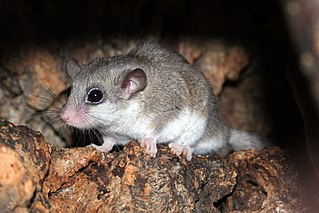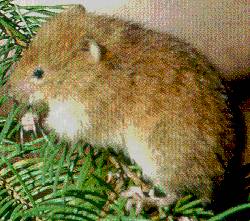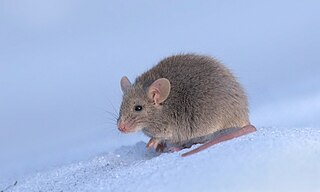
A dormouse is a rodent of the family Gliridae. Dormice are nocturnal animals found in Africa, Asia, and Europe. They are named for their long, dormant hibernation period of six months or longer.

The harvest mouse is a small rodent native to Europe and Asia. It is typically found in fields of cereal crops, such as wheat and oats, in reed beds and in other tall ground vegetation, such as long grass and hedgerows. It has reddish-brown fur with white underparts and a naked, highly prehensile tail, which it uses for climbing. It is the smallest European rodent; an adult may weigh as little as 4 grams (0.14 oz). It eats chiefly seeds and insects, but also nectar and fruit. Breeding nests are spherical constructions carefully woven from grass and attached to stems well above the ground.

The Muridae, or murids, are either the largest or second-largest family of rodents and of mammals, containing approximately 870 species, including many species of mice, rats, and gerbils found naturally throughout Eurasia, Africa, and Australia.

Micromys is a genus of small rodents in the subfamily Murinae. The genus contains two living species: the widespread Eurasian harvest mouse of much of Europe and Asia; and the more restricted Indochinese harvest mouse of Vietnam, southern China, and perhaps nearby regions. Fossils of Micromys date back to the Late Miocene and include at least 10 extinct species, which form several lineages.

The Old World rats and mice, part of the subfamily Murinae in the family Muridae, comprise at least 519 species. Members of this subfamily are called murines. In terms of species richness, this subfamily is larger than all mammal families except the Cricetidae and Muridae, and is larger than all mammal orders except the bats and the remainder of the rodents.

The genus Arborimus is a group of voles found in western North America. The genus name is Latin for "tree mouse". Some sources include this genus with the heather voles, genus Phenacomys, and both are classified in the tribe Phenacomyini.

Zapodidae, the jumping mice, is a family of mouse-like rodents in North America and China.

The Asiatic long-tailed climbing mouse is a species of rodent found in South and Southeast Asia. It is known as Sinhala: ගස් මීයා by Sinhalese people.

The genus Mus or typical mice refers to a specific genus of muroid rodents, all typically called mice, though the term can be used for other rodents. They are the only members of the tribe Murini. However, the term mouse can also be applied to species outside of this genus.

Chiropodomys is a genus of Old World rats and mice native to Southeast Asia and northeast India. They are tree-dwelling, very small mice, mostly found in tropical rainforest. In total six extant species have been identified, but only one of these, Chiropodomys gliroides, is common and widely distributed, and has been extensively studied.

Birch mice are small jumping rodents that resemble mice with long, tufted tails and very long hind legs, allowing for remarkable leaps. They are the only extant members of the family Sminthidae. They are native to Eurasian forests and steppes. All variants possess a long tail of 65 to 110 mm of length and weigh about 6 to 14 g. Head and body length of 50 to 90 mm and hind foot length of 14 to 18 mm. The animal's skin color is light brown or dark-brown to brownish yellow on the upper side and paler on the underside, but generally brownish. Birch mice have a vast geographic distribution in that they inhabit a wide variety of habitats, from semiarid areas to subalpine meadows. Although they have a diverse region of areas, their molecular and anatomical markers have claimed that Birch mice originated from Central Asia. Birch mice have a systematic of the genus of Sicista, they look at the male reproductive organs and cytogenic data.
Long-tailed climbing mouse may refer to:

Phyllotis is a genus of rodent in the family Cricetidae. These mice are commonly confused with Auliscomys, Graomys and Loxodontomys.. In order to tell these genera apart, one must look at the tail. Species in the genus Phyllotis have a penicillate tip on their tail which is not present in the other two genera. Tails in the genus Phyllotis are also less than the length of its head and body combined whereas in Graomys, tails are longer than the head and body combined. Phyllotis xanthopygus was found at the summit of Volcán Llullaillaco, which is the highest altitude a mammal has yet been found in nature.

Nolthenius's long-tailed climbing mouse, also known as Sri Lanka highland tree mouse or Podi-gas-miya, is a species of rodent in the family Muridae. The species is endemic to the highlands of Sri Lanka. It is a nocturnal arboreal mouse, which is named after A. C. Tutein-Nolthenius, an amateur zoologist who collected the first specimens in 1929.

The prehensile-tailed hutia is a small, furry, rat-like mammal found only in forests on Cuba. It is the only member of the genus Mysateles. It climbs and lives in trees where it eats only leaves, and it is threatened by habitat loss. The prehensile-tailed hutia is a member of the hutia subfamily (Capromyinae), a group of rodents native to the Caribbean that are mostly endangered or extinct.

The Atlantic Forest climbing mouse is an arboreal rodent species in the family Cricetidae from South America. It is found in the Atlantic Forest of southeastern Brazil at elevations from sea level to 1500 m. It utilizes the ground more than the understory in isolated forests however this utilization changes in certain areas of the Atlantic Forest where it prefers to use the vegetation canopy. Its karyotype is 2n = 44, FN = 74–80.

The cerrado climbing mouse or long-tailed rhipidomys is an arboreal rodent species in the family Cricetidae from South America. It is found in primary or secondary forests of the cerrado and caatinga in central and eastern Brazil, and has also been seen in the Atlantic Forest. Its karyotype is 2n = 44, FN = 48-52. They are nocturnal animals and can be found in both tree canopies and on the ground.

Nilgiri vandeleuria, also known as the Nilgiri long-tailed tree mouse and the Indian long-tailed tree mouse, is a species of rodent in the family Muridae. There has been some dispute as to whether this specimen is actually a subspecies of the Asiatic long-tailed climbing mouse but current opinion seems to suggest that it is indeed a separate species. It is found in India.

Hydromyini is a very large, diverse tribe of muroid rodents in the subfamily Murinae. They are the dominant native rodents in Australasia and one of only two native rodent groups there, the other being the R. fuscipes group of the genus Rattus in the tribe Rattini. They are also found in parts of Southeast Asia.
















